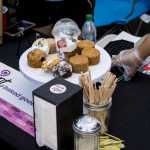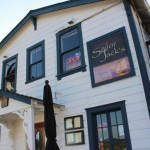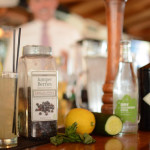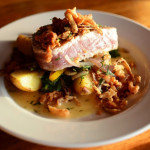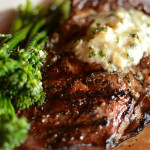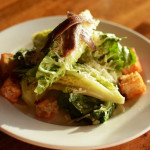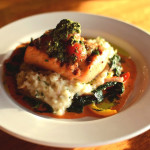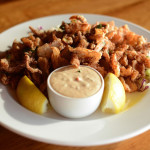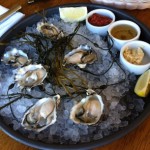Savor the Season
By Chef K. Marie Paulk
Here we are in the middle of summer. Can you believe the year is almost halfway over? It’s time to start thinking about how to enjoy the fruits and vegetables of the season. If you’re thinking that I’m going to be covering summer cooking, you are correct! If you guessed grilling, you would be incorrect. I’m instead going to discuss the next best thing: summer soups. It may not sound as exciting as grilling a ribeye, but it really can be just as flavorful.
My favorite is the import from Spain, gazpacho, but with a twist—a creamy gazpacho. For centuries Spanish field workers combined their leftover odds and ends to make a tasty potage. The tomato wasn’t even added to the soup until the explorers brought it back from the New World. Every region of Spain prides itself on its version of gazpacho, but Spain’s southernmost region, Andalusia, is the soup’s true home.
This recipe is a simple blend of cucumbers, bell peppers, onions, tomatoes, and bread added for body. I would recommend a few modifications to make a creamy gazpacho. When adding the olive oil, drizzle it in so the mixture can emulsify, creating a silky texture. Avoid English cucumbers, as they have higher water content than regular cucumbers, which only require a few extra minutes to scoop out the seeds. Salt your vegetables at least an hour before you purée. Also, before you purée the vegetables, put them in a strainer and capture the vegetable liquid in a bowl. Soak your bread in that vegetable liquid before you add it to the soup. If you make the gazpacho the night before, it will allow the flavors to intensify, much like a tomato sauce, and you will have a richer tasting soup. Sound simple enough? But what about all the other vegetables available to us now, like asparagus, carrots and sweet peas?
Grilled asparagus is great, and it’s just as good blended and made into a soup. Freshness is key; if they give off an unpleasant odor, they’re too old. The ends should be moist, not dried out. To keep the asparagus fresh, stand the spears in shallow water in your refrigerator, but do so only for a couple of days. Some feel the thicker spears are the more tender and sweeter — and for a soup, I prefer them — but I would favor the thinner ones for grilling. White and purple asparagus are now more commonly available, too. The white varieties are mounded with soil to keep the sunlight out, because the spears develop in darkness (they don’t produce chlorophyll). Their skin is a bit tougher and the flavor is milder. If you happen to find purple asparagus, add vinegar or lemon juice to the spears before cooking to prevent their discoloring. A purple asparagus soup would be very pretty and a great way to stump your guests. I use a sautéed leek and yellow onion along with a homemade vegetable stock for my asparagus soup to make it even more flavorful.
Now, carrots—one of my favorites. I love their many colors, from purple to white, and their shapes, slender to chubby. Their flavor, however, is what I love the most. Luckily, carrots are available throughout the year at the local grocery store and are always good! I find the carrots with the best flavor are those that are harvested in the late spring and early summer. Carrots from late summer to early fall have a more complex and sweet flavor, which is the result of the colder temperatures converting the roots’ starches to sugars; roasting these carrots is the best option. The shelf life for a carrot is relatively short: baby carrots hold up for about five days and a more mature carrot should last about two weeks. As such, store your carrots in the coldest part of the refrigerator and keep them in a plastic bag. The combination of ginger, fennel, leeks, and carrots make a wonderful soup.
While not my favorite, I know that split pea soup remains very popular. The sweet pea is hard to find and keeping them fresh is the issue. The travel time between the growers and the market is even enough to dry up their juices, turning the sugars into a starch. The pod should appear swelled—but not too big, or you will find the peas inside will be too starchy. If the pods are too small, the pea will probably not be larger than a small bead. The peas themselves should look moist and not too big. Fresh sweet peas, spinach, and coconut milk will make a delightful soup.
There are a lot of ideas for summer soups, which could be an added treat on a summer day. Grilling and a cool soup for dinner will always make a winning combination. As an added plus to making your own, you can control the sodium, mainly by using Kosher salt instead of table salt. If any of these recipes seem interesting, I will post them on the Local Happenings website. So enjoy all the gifts we’re about to receive from the earth (fruits included)—the season won’t last very long.
A Deliciously Hidden Gem in Benicia
Here is a hidden gem in my hometown of Benicia—Whipt Baked Goods, and chances are that you probably have passed this new business without even noticing.
Whipt is located on East 2nd Street, in a white-colored building that is inside the Lee Professional Plaza. It is right next to the Benicia Cat Clinic and across the street from Rrags Caffe and Nation’s Giant Hamburgers. When the white and pink Whipt tent is out, you will know it is open.
I want to first clear the air and let you know that Whipt is more than just a bakery––it bakes custom goods with local, organic ingredients and caters while also providing freshly baked goods during walk-in times. Of course, with Rosanna’s European Delights and now Diana’s Bakery on 1st Street, it may seem excessive to have that many bakeries in such a small city at first—but they are all unique in their own way, specifically in what they provide, and their locations (i.e., Diana’s is right across the street from the Benicia State Capitol, while Rosanna’s specializes in European goods and has been in Benicia the longest at its water-view location).
I experienced Whipt for myself during one of their walk-in Wednesdays on “Whipt Wednesday.” I saw and was greeted by my new friend, Whipt’s owner and creative mind, Krizelda Osada, though she goes by Krizy. I was also greeted by a friendly girl who told me about each of the gourmet goods in the display case, such as the blueberry scone that sounds even more amazing when warmed up. Other choices were gourmet “cookiecakes” like the red velvet cookiecake or the snickerdoodle cookiecake, beautifully garnished with almonds and drizzled with frosting—delicious art. The girl explained that the cookiecakes could also come “naked” (without garnish).
Out of all the choices, the Whipt French toast looked the best at the time since I had not eaten breakfast. I was also offered an iced coffee, and I immediately wanted that as well—very refreshing on a hot day. Without a long wait at all, everything was freshly made to safely take back home in a nice white box.
But before I left, Krizy let me try her summer chili, which she told me is “organic, from grass-fed cows.” The chili was nice and warm with melted cheese, hefty chunks of meat, and a nice zing to it that was not too spicy—just the way I like it. She also gave me one her most popular goods, the chocolate chip cookiecake. From the very first bite, I tasted why they are so popular because I now want to order a dozen—try one and get Whipt!
In addition to the goods, what I like about Whipt is all the passion that goes into the business. Krizy works hard doing what she loves, and she was passionate about baking before even starting her business. “I baked through college,” Krizy said, “as a way to decompress after stressful final exams. I baked with my nieces and nephews when they were little, as a way to share time with them. I baked through tough pregnancies to cope with the pain and nausea.”
My favorite story was about how Krizy baked through the labor of her children. “My husband would try to hurry me out of the kitchen and into the car,” Krizy said, “so that he could rush me into L&D at Alta Bates Hospital in Berkeley. For the labors of all three of my babies, I refused to go to the hospital until my batch of chocolate chip cookies were done baking, cooling and bagged up. At check-in for each of my children’s deliveries, I would present my nurses with a bag of my fresh baked, homemade chocolate chip cookies. I was told everyone loved them!”
Whipt first started out as a home-based operation with a dream to expand, and working hard and building rapport with people really helped make that happen. Krizy was the first to get a Cottage Food Permit in January of 2013. “Being the first trailblazer within the Cottage Food industry gave me the stage to make some noise. The local news was interested in this new permit, what it would mean to the home-based baker’s in California,” Krizy said.
Krizy made connections with old and new local businesses to sell her goods with them, such as in the old candy shop that used to be on 1st Street in Benicia (anyone remember Spoonful of Sugar?). She also vended at my favorite coffee place, Moschetti Artisan Roaster in Vallejo, during their Saturday tasting events.
Her business really took off when she sold at the Soma Street Food Park, a place that had food trucks and live music in San Francisco. Krizy came up with a great idea to put edible graphics on her cookies. “I decided to put golden era hip hop and Bay Area legendary musician album covers on my cookies, as a nod to the local hip hop and DJ community,” she said. “This nod would surprisingly sweep folks off their feet. It blew my hair back to see so many people flood my cookie booth with pure joy, excitement and even tears of joy as they dug through my cookie crates for their favorite album covers. What’s more was that folks truly enjoyed the taste of my cookies!” Krizy made a lot of connections this way.
Whipt officially opened on February 26th, 2016 and recently celebrated their one-year anniversary. For its opening, Krizy said, “We hosted a blessing ceremony for a newly built Whipt Bakery and invited the neighborhood, local community, and everyone to partake. With the help of talented DJ friends & family, we gave away free Whipt Cookies and Philz branded coffee (thanks to the kind cup donations by Philz Coffee).”
Visit Whipt Baked Goods at 1440 East 2nd St. Ste A, Benicia. It is currently open most Wednesdays for Whipt Wednesdays from 7 a.m. to 4 p.m. Otherwise, it is open daily by appointment. For additional information and orderings, call (844) 44-WHIPT, email them at orders@whiptcookies.com, like Whipt Cookies on Facebook, or go to their website at whipt.myshopify.com or whiptcookies.com.
 James Quinn lives in Benicia and teaches at Elmer Cave Language Academy in Vallejo. A UC Davis alumnus in English, he now studies education as part of Touro University’s Master’s in Education program. Along with teaching, he tutors and writes often. He is working on a novel that takes place in Benicia. See his website at mrquinnj.weebly.com.
James Quinn lives in Benicia and teaches at Elmer Cave Language Academy in Vallejo. A UC Davis alumnus in English, he now studies education as part of Touro University’s Master’s in Education program. Along with teaching, he tutors and writes often. He is working on a novel that takes place in Benicia. See his website at mrquinnj.weebly.com.

More than a View
When it comes to dining by the Carquinez Strait, the views don’t get any better than what you can find at Benicia’s Sailor Jack’s restaurant. Sitting inside, guests are almost parallel to the water and can gaze upon the Carquinez Bridge and Alfred Zampa Memorial Bridge out in the distance. While the first floor is closer to the water, Sailor Jack’s’ seating upstairs gives a more panoramic view. Overall, the scenery’s almost enough to distract you from your meal—nothing is quite like it.
However, even if they shuttered up the windows, Sailor Jack’s would still stay afloat, thanks to its exquisite, ever-evolving offerings. Lead by Head Chef Joel Ramos, Sailor Jack’s features a menu that “is naturally complemented by a carefully curated selection of great wines and signature cocktails also available in our comfortable upstairs bar.” Ramos, a master chef in fresh seafood and many other categories, takes a very hands-on approach. Since joining the team in 2015, Ramos has revamped the interior, added more dining space on the outside, and given the bar a makeover as well. He makes sure Sailor Jack’s’ ingredients are high quality and does the restaurant’s butchering himself. When Local Happenings Magazine visited, Ramos was carefully planning a banquet scheduled on the upstairs dining area that evening.
Sailor Jack’s is located at the end of First Street in Benicia (their address is very easy to remember: 123), in a building that is getting ready to turn 150 next year. Longtime residents may remember Sailor Jack’s predecessor, Captain Blythers, which occupied the building for years. Its original function, fittingly, was the elegant home of a sea captain, and it has worn many hats since then. As Sailor Jack’s owners say, “[Our building] has evolved from a respectable sea captain’s home, to a notorious brothel, to its current use as Sailor Jack’s—a place where scrumptious food, inspired libations, warm, hospitable service, and great times are waiting to be celebrated.”
When the building’s current owners took over they renovated the space to give it a simpler look that helps augment the beautiful waterfront view. Sailor Jack’s also pays tribute to history—not just with its antique furniture and pictures of old scenes at sea—but also with its name: The restaurant is a tribute to Jack London, who was a great American author, adventurer, and sailor.
London, of course, is one of Benicia’s claims to fame. He famously proclaimed: “I would rather be ashes than dust! I would rather than my spark should burn out in a brilliant blaze than it should be stifled by dry-rot … I shall not waste my days in trying to prolong them. I shall use my time.” And he lived his life accordingly, embarking on adventures that made him a legend. He traveled the world, crossed the Pacific Ocean as a sailor, and then again as a war correspondent. He prospected for gold in the Yukon and then pulled from his experiences there to write the timeless novel Call of the Wild, which fittingly is the inspiration behind one of Sailor Jack’s most popular house cocktails (a tequila drink with jalapeño peppers and cucumbers) of the same name. London cheated death many times (almost drowning in the Carquinez Strait), and he once remarked that he was happy that several strokes of luck allowed him to live through his early 20’s, because the next 20 years after that were the best of his life. However, before he achieved fame and glory (writers in his day were akin to rock stars, of course), London’s first taste of adventure came when he decided to briefly become a Benician.
London fell in love with Benicia because of its downtown bar scene and sailed on both sides of the law. He first became an oyster pirate and was then hired on by the California Fish Patrol—ironically—to arrest oyster pirates and illegal fishermen. He recounted embellished versions of these adventures in his collection of short stories, Tales of the Fish Patrol, which centers on Benicia. In it, London describes chasing down illegal fishermen, getting stranded on a sand bar in the waters around the strait, and literally turning the tide on a notorious oyster pirate named “The Centipede.” The book has a special meaning for all locals, and it is an inspiration to the owners of Sailor Jack’s, who note that London introduced himself as “Sailor Jack” when he traveled to Alaska to take part in the Yukon Gold Rush.
You can’t just visit Sailor Jack’s once to get the full experience. Its menu changes throughout the day and it switches around with the changing seasons as well. However, if you can only go to Sailor Jack’s once, make it on a Saturday or Sunday during the morning, as brunches at Sailor Jack’s are a local favorite. They feature zesty buttermilk pancakes and French toast decorated with berries, both served with warm syrup. For dinner, they have delicious lobster tail, Dungeness crab cake salad, and big Texas (spicy smoked pulled pork topped off with Monterey jack and cheddar cheese and served with crunchy fries). They’ve also got a range of steaks, and a $7 clam chowder. Their garlic fries are first-rate. Sailor Jack’s owners say it’s the: “finest dining experience imaginable amidst the ebb and flow of the tides. As our guest, you are always welcome aboard.”
Sailor Jack’s is located at 123 First Street in Benicia. It is open from 11 a.m. to 9 p.m. on Monday through Thursday, from 9 a.m. to 10 p.m. on Friday and Saturday. On Sunday, it is open from 9 a.m. to 9 p.m.
Brunch and breakfast are served from 9 a.m. to 3 p.m. on weekends, and dinner starts at 5 p.m. seven days a week. Also, Sailor Jack’s has a happy hour that goes from 3 p.m. to 5 p.m., from Monday through Friday.
For additional information, visit them at sailor-jacks.com. Like them on Facebook and get updates on daily specials and deals by visiting: facebook.com/SailorJacks. To schedule a reservation, call (707) 746-8500, or email them at info@sailor-jacks.com or events@sailor-jacks.com.

By Nate Gartrell
Nate Gartrell grew up in Benicia, studied journalism in college, and has written for a handful of media outlets since age 15. He aspires to visit all 30 Major League Baseball stadiums and to hit the trifecta at the horse track.

Whether you’re rich, poor, young, old, male, or female, everybody wipes their face at least once a day. But the word “napkin” doesn’t resonate anywhere quite like it does in the town of Napa. Here, napkins take on a special meaning, and that’s not just because the Napa Valley is internationally known for its wining and dining. In Napa, the term “napkins” has also been adopted as slang for longtime Napa residents. Some recoil at the term, but most wear it with pride. And for the past three years, local “Napkins” have had a restaurant of the same name, which seeks to embody the more than 140-year-old town.
“It refers to people who live and breathe the Napa life every day,” a 2013 news release for the Napkins restaurant said of the eatery’s name. “It expresses love and appreciation for the beautiful valley that surrounds us.”
Napkins sits in downtown Napa, alongside the Napa River. Inside, bottles of fine wine and liquor seemingly float against the bar wall, with an indoor waterfall behind them. Outdoors, a spacious patio area allows visitors to catch a great view of the water and enjoy a sunny Napa afternoon.
Fittingly, the restaurant’s name was chosen by Napans themselves, Napkins owner Ali Yildirim said.
“We asked locals and people on our Facebook page to name the place, and ‘Napkins’ was the most popular,” Yildirim said. “Napkins means: anyone who appreciates good food, good wine, and good weather. There is a restaurant called ‘Fork,’ ‘Knife,’ ‘Spoon,’ and we have the ‘French Laundry,’ so this fits right in with that.”
Napkins’ interior pays tribute to Napa natives, lined with a photographic timeline of the town’s history going back 200 years—well before Napa was incorporated. There is also a timeline integrated into a window near the entrance, detailing advancements and notable events throughout Napa’s history. Napkins’ founder, Yildirim, said he felt a need to reflect his city as much as possible.
“I want Napa locals and tourists to be able to actually see the history while they’re enjoying their food and drinks,” Yildirim said. “There’s a written part and a pictured part; you can literally walk through and in one or two minutes get a great look at Napa’s history.”
Yildirim is part of a family of restaurant owners that goes back three generations. He has managed restaurants in Turkey, the East Coast, and throughout the world. Having been born into the restaurant business, Yildirim said he “started as a dishwasher, from that to a busser to cook, then later a manager, and owner. I’ve pretty much been at all the positions.”
“I am just following my family’s legacy,” Yildirim added. “It’s something I love; I love people, I love food, and I love hosting people and making them happy. One easy way to do that is to just give them great food and service.”
He first came to Napa from New Jersey in 2010, setting up the successful Tarla Mediterranean Grill on First Street. Before that, he spent years in the cruise ship business.
“I’ve been to 50 countries, and I gained a lot of understanding of humans, food, and culture,” Yildirim said. One basic thing he learned?
“Happy belly, happy face,” Yildirim said, with a smile.
To that point, Napkins offers a range of American classics that have an international twist. Its Niman Ranch burger is stacked with arugula, fried onions, and vegetable relish, and contains layers of delicious flavors. Its porkchops come with garlic mashed potatoes and cranberry, apricot, and apple compote. Napkins’ head chef, Erasto Jacinto, co-wrote the acclaimed cookbook Big Small Plate with Cindy Pawlcyn and Pablo Jacinto. Erasto’s 20 years in the business include various chili cook-off championships and more than one head chef position. When asked, Yildirim couldn’t settle on just one favorite of Erasto’s dishes.
“Our brisket sandwich is amazing, and our grilled tostada fish of the day is really unique and a top seller,” Yildirim said. “I don’t think anyone does wings like us, that’s why we call them Napkins’ Wings. Those are a few of my favorites, but really it’s like asking me to pick my favorite child. I can’t pick my favorite child, I love all my children.”
On Friday and Saturday nights, from 10 p.m. to 1 a.m., Napkins is transformed into an upscale club with music provided by DJ’s, including—recently—DJ Big Cali and DJ Raamm. When they dim the lights, the wall waterfall is illuminated, creating a stunning effect behind the bar.
“Those bottles look like they’re floating in the water,” Yildirim said. “First we please the eye, then the stomach.”
They also have an ongoing, daily happy hour that Yildirim said he was proud of.
“Draft beer is three dollars, and most items are 50 percent off. We don’t shrink the size or portion, we give you the same,” Yildirim said. “Between 3-6 a day, seven days a week. It’s a killer deal.”
Napkins features more than 100 wines, dozens of brunch special items on weekends, and an assortment of other deals. Yildirim said that he takes the restaurant’s name seriously, and that with it comes a duty to embody what the town is all about.
“Not so many people knew of Napa’s history,” Yildirim said. “I thought that I was responsible to show tourists that Napa has a history, and that everything around us didn’t happen overnight. There are 200 years of good history that made Napa what it is today, and I think that should be known and respected.”
Napkins is open seven days a week starting at 11 a.m. Its kitchen closes at 11 p.m. on Friday and Saturday, and brunch goes until 3 p.m. on weekends. For more information, call them at (707) 927-5333, visit them at 1001 Second Street in Napa, and follow them on Facebook at Facebook.com/napkinsnapa or Facebook.com/napkinsnights.
Editor’s Note: “We love the Happy Hour at Napkins! It’s the best, great food and cocktails make for a great time for John and I.” – Deanna Baillie
 Nate Gartrell grew up in Benicia, studied journalism in college, and has written for a handful of media outlets since age 15. He aspires to visit all 30 Major League Baseball stadiums and to hit the trifecta at the horse track.
Nate Gartrell grew up in Benicia, studied journalism in college, and has written for a handful of media outlets since age 15. He aspires to visit all 30 Major League Baseball stadiums and to hit the trifecta at the horse track.
The Land of Enchantment

By Chef K. Marie Paulk
This is a little different from my normal tale, and I am not turning into a travel writer. I wanted to share some thoughts from a recent trip, which is pertinent to FOOD. Each of you, I am sure, has a favorite getaway destination; a place you might call your … personal land of enchantment? My husband and I just took a 10-day trip to one of my favorite places: Santa Fe, New Mexico. Something about New Mexico has held a special place close to my heart. To me it feels magical, the big purple sky, the landscapes … no matter how many times I visit I never seem to tire of this town of about 70,000. Another good reason I love to visit is because it is definitely a foodie town. The best part of our days there was planning on where and what we would eat for dinner. There is always something new to try, but I never tire of the green enchiladas or green chili stew. In New Mexico, chile and chili are two very different foods. Chile refers to hot peppers, while chili refers to a hearty dish made with protein, peppers or chile powder. The third spelling is used by the British – chilli. The word chile/chili evolved from the Aztec word chil, which translates to “pepper.” The Spanish added the “e,” and we can thank Conquistador Don Juan de Onate for bringing the green pepper to Hatch, New Mexico. There is no better smell in the world to me than chiles roasting on a crisp fall day. Hatch is in southern New Mexico and should not be missed if you are in the area around Labor Day when they hold their annual Chile Festival. The red chile is grown north of Santa Fe in a tiny village of Chimayo. There is a huge difference in the makeup of the New Mexico red chile powder to the regular chile powder you find in the spice section of where you shop. If you are lucky enough to visit a market that carries New Mexico red chile that is the one you should choose.
While on the trip I wandered into the Santa Fe Museum. I am not going to provide a history lesson, but I did learn several interesting facts about the Harvey Girls and Georgia O’Keeffe. I know you might be wondering where I’m I going with this—I did not know anything the about the Harvey girls, but my curiosity was piqued when I saw a t-shirt that read, “Harvey Head.” Fred Harvey, who was in the hospitality business in 1880s, has a following, similar to the Dead Heads of the music group the Grateful Dead. His motto was “3,000 Miles of Hospitality.” He built the Montezuma Hotel outside Las Vegas, New Mexico in 1882. What he is really known for is building an empire that revolutionized the way people travel across the country. I’ve read that he thought his biggest challenge would be procuring high quality fresh foods in the middle of nowhere or dealing with outlaws. He was wrong; his problem was in finding good help. He started looking for waitresses back east, and with the help of his wife (who met with each new hire to make sure they could live up to the strict etiquette standards), he brought to life the “Harvey Girl.” There was even a movie made called the Harvey Girls starring Judy Garland, based on a novel of the same name. The women became such popular cultural icons that many of them married their customers. In an effort to keep them, Harvey paid them a good salary of $17.50 a month and required them to sign an employment contract that would cause them to forfeit a portion of their salary if they quit within a year. At the peak, the Fred Harvey Company operated 30 dining cars on the Santa Fe Railway. The standards were high, the food fresh and portions generous. A 50-cent breakfast included fruit, steak, eggs, hash browns and a stack of six pancakes. The most famous breakfast was the Fred Harvey French Toast, created for the railway in 1918 and also known as Pain Perdu, a French term for “lost bread.” I don’t know why I find this so interesting, but I think it must have been pretty glamourous and fun to be traveling by rail and eating wonderful food while enjoying the sights.
Another interesting tidbit I discovered was about the painter Georgia O’Keeffe. I love her work. Santa Fe has an entire museum devoted to her, which I have visited several times and strongly recommend. Miss O’Keeffe was quite a foodie herself and she was way ahead of the times. In 1940, when she settled in Abiquiu (about 80 miles out of Santa Fe), she created a sustainable residence. All but her proteins she grew organically and made everything herself. She also developed quite a following. Her home stands today as a National Historic Landmark. If you want to visit, make reservations as it is often sold out. Her kitchen and studio are the focal points of the home (like most). She is a true inspiration to me. Her painting, Jimson Weed, sold for $44.4 million in 2014. Reading and learning about all of her accomplishments both inspires me and makes me hungry for green chili enchiladas.

Cheese (and bread), has always been my downfall. I have always thought that if it wasn’t for cheese I would be thin. I have little to no control about this complete protein. I’m sure we can all remember those yummy grilled cheese sandwiches or mac and cheese from the box growing up. I’m sure we all realize that these dishes were made with processed cheese. I’m not above eating processed cheese (nachos come to mind), but I prefer medium cheddar cheese. Let’s face it, processed cheese is great for melting, it liquefies, and maintains its stretch. Unfortunately, a lot of cheeses are not meant to be warmed and they can become drier and stiffer. The amount of moisture, salt and acidity will determine how the cheese will melt when it is heated. Cheese is always made from milk. The texture of a cheese depends on water content. The fat content in a cheese can range from as little as 1% to 75%. The terroir of the milk, the time of year the animal grazed and, believe it or not, the time of day the animal is milked (this is starting to sound a lot like wine making) will affect the flavor of a cheese. That is just the tip of the iceberg. Other factors have to be taken into account as well—is the milk pasteurized or raw, the culture, aging process used, etc. I have read that there are 7 steps in making a basic cheese, which reminded me of stock making. The steps are:
- Coagulation
- Cutting the Curd: The solid element of the milk
- Cooking the Curd
- Draining
- Salting
- Molding and Pressing
- Ripening: This has to happen naturally to form a rind, cloth or leaf bound, wax rind and/or brine cured
We should all appreciate how lucky we all are for living in an area where there are all kinds of artisan cheese makers (Cowgirl Creamery comes to mind). I remember this cheese store we paid a visit to during culinary school in Beverly Hills named, of all things, The Cheese Store. An odd location for cheese, but this place was well known, had been there for years (1967) and was known by many in the industry. The owners of the store are just a wealth of information, not to mention the 200 or so types of cheese they have. Every time I’m asked to make a cheese platter I try to add a new cheese and make sure there is an assortment of semisoft cheese, hard cheese and maybe a blue cheese with drizzled honey. I try to school myself, and maybe my guest, on the assortment. This could be classified as a cheese course. When serving cheese remember to allow it to come to room temperature. Cold cheese has only a fraction of the flavor. Also, avoid cheese that is vacuum-sealed in plastic. With all the varieties available, getting to know all the types can be never ending. New varieties of cheese have been developed ever since the process was discovered—by accident. Yes, by accident! As with all fermented products it is believed the curdling action was noticed when a herdsman poured milk into a pouch made of an animal’s stomach and some form of cheese was created. So the question is, where do you begin? I recommend starting with what you like. I prefer soft ripened cheese. My personal favorites are: brie, double creams and the best triple creams. Double and triple creams have been enriched with the addition of, well, cream! This style was created in Normandy, France in the early 1900’s. They were first known as the “cheese of affluence” because the added cream was a luxury. Double creams contain a minimum of 60% butterfat; triple contain 72%. Another one of my favorites is cheddar, medium to sharp. Sharp is a little too intense for my husband so I tend to buy medium. The term “sharp” indicates the cheese has been allowed to age longer which creates a sharper flavor. Currently I have been using an Irish cheddar that has a great flavor. Cheddar refers to cheese in which curds have been cut, stacked, drained, restacked, milled, salted and pressed. There’s something to note about another favorite of mine, Parmigiano-Reggiano and plain Parmesan cheese. Parmigiano-Reggiano is made only in the Emilia-Romagna region of northern Italy. The milk used comes from cows that graze in grassy meadows. Each wheel is aged for at least 12 months before it is stamped and shipped to market. This cheese is one of the most copied cheeses on the market, which is found to be salt laden and mass-produced from cows that are penned in and grain fed. Also, rather than buying the pre-grated—which loses moisture and flavor—buy a chunk and grate it yourself, you will notice a difference. I would be remiss if I did not mention Gruyere, which is a Swiss cheese from the western hills of Switzerland that no French onion soup would be complete without. Go out now and try a new cheese, but just remember to wrap up any leftovers and refrigerate them since after 4 hours they tend to dry out and deteriorate. By Chef K. Marie Paulk

